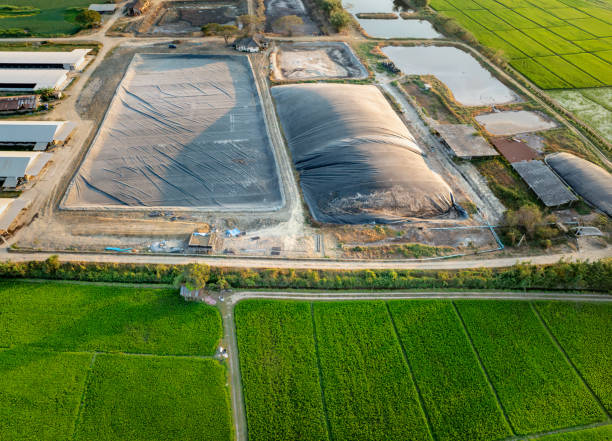
Anaerobic Digester System
Sustainable waste management is more important than ever. Industries are looking for new ways to clean wastewater and maximise resource recovery. Anaerobic digesters process organic waste and generate sustainable energy. These systems are extremely effective and capable of producing enormous amounts of biogas, which can be used to fuel cars or to create power and heat in industrial power plants. Investing in anaerobic digester system benefits communities and organisations that want to enhance their sustainability, raise revenue, and reduce waste disposal expenses and the environment.
This article will explain how anaerobic digester systems work, their benefits for water recycling and industrial operations, and their significance in current industrial water treatment.
Understand Anaerobic Digestion
What is an anaerobic digestion?
Anaerobic digestion involves microorganisms breaking down food waste, agricultural waste, and sewage sludge without oxygen. This process turns these components into biogas, mostly methane and carbon dioxide, and digestate, a nutrient-rich fertiliser. Sealing a vessel aids in anaerobic digestion. The ideal atmosphere for microbes helps break down organic materials. Anaerobic digestion’s sustainable waste management and energy generation make it ideal for enterprises with huge amounts of organic waste.
How Does an Anaerobic Digester System Work?
- Feedstock Preparation
Anaerobic digesters start with feedstock preparation. Feedstock can be organic items like:
- Restaurant and processing food waste
- Manure and crop remnants
- Sludge from wastewater treatment plants
- Organic-containing industrial process water
Shredding or screening feedstock reduces particle size and removes non-organic impurities before feeding it into the digester. Optimising digestion requires feedstock pretreatment.
- Digestion
The anaerobic digester system receives prepared feedstock. The digestive process has multiple steps:
- Hydrolysis: Hydrolysis breaks down carbohydrates, proteins, and lipids into simpler molecules. Enzymes from hydrolytic bacteria turn solid organic materials into soluble organic matter.
- Acidogenesis: Fermentative bacteria break down hydrolysed soluble organic matter to create VFAs, hydrogen, and carbon dioxide. This step is critical for biogas production.
- Acetogenesis: Acetogenic bacteria produce acetic acid, hydrogen, and carbon dioxide from VFAs and other acidogenesis intermediates. Methanogenic bacteria convert acetic acid into methane.
- Methanogenesis: In the final stage of anaerobic digestion, methanogenic archaea convert acetic acid, hydrogen, and carbon dioxide into methane (CH₄) and carbon dioxide. This stage produces biogas that can be used as renewable energy.
- Biogas Production and Use
A gas holding or tank stores anaerobic digester biogas. This renewable energy has many uses:
- Electricity Generation: Biogas can power a generator to generate electricity for on-site usage or sale to the grid.
- CHP Systems: Biogas can be burned in a CHP system to generate power and heat for process or facility use.
- Upgrade to Biomethane: Hydrogen sulphide and carbon dioxide can be removed from biogas to make biomethane, which can be fed into the natural gas grid or used as fuel.
- Digestive Management
After digestion, digestate is nutrient-rich and can be utilised as a soil amendment or fertiliser in agriculture. Digestate must be managed properly to maximise advantages and minimise environmental consequences.
Advantages of Anaerobic Digester Systems
- Industrial Wastewater Treatment: Industries with large organic wastewater volumes benefit from anaerobic digester system. Industries can comply with regulations and reduce municipal wastewater treatment facility load by processing wastewater on-site. This is crucial for organic waste-intensive businesses, including food processing, brewing, and agriculture.
- Water Recycle: Industries can recycle water from digestate through anaerobic digestion. After treatment, this water can be used for irrigation or industrial activities, lowering water use and boosting sustainability.
- Energy Production: Anaerobic digesters produce renewable biogas, helping the industry minimise fossil fuel use. Industries can reduce expenses and promote energy sustainability by generating their energy.
- Lower GHG Emissions: Organic waste treatment using anaerobic digestion reduces greenhouse gas emissions. Instead of being discharged into the atmosphere, methane is caught and used. This aids global climate change initiatives.
- Nutrient Recovery: Anaerobic digestion produces nutrient-rich digestate that can be utilised as high-quality fertiliser to enhance sustainable agriculture and reduce chemical fertiliser consumption. A circular economy that turns trash into resources is promoted.
Industry Applications of Anaerobic Digester Systems
- The food and beverage industry
Anaerobic digester systems are appropriate for food and beverage waste, which is high in organic matter. Companies can decrease disposal expenses, create renewable energy, and promote sustainability by treating food waste on-site.
- Farming
Agriculture commonly uses anaerobic digestion to handle crop waste and animal manure. Biogas from these wastes can power farms and make nutrient-rich fertilisers.
- Drug and chemical industries
Anaerobic digesters can treat organic effluent from these businesses. Companies can lessen their environmental impact and comply with requirements by treating process water on-site.
- Municipal Wastewater Treatment
Municipal wastewater treatment plants use anaerobic digesters to process sewage sludge and organic waste. This boosts wastewater treatment efficiency and resource recovery.
- Industrial Power Plants
Anaerobic digestion systems can manage energy-related organic waste in industrial power plants. Biogas capture and use can improve sustainability and reduce waste in these operations.
Issues and Considerations
- Initial Investment
While anaerobic digester system have several benefits, the initial investment is high. Industries must assess long-term ROI and explore government grants and incentives for financing.
- Operations Management
Successful anaerobic digester operation demands experienced staff and good management. Industrial training and monitoring are essential for biogas production and performance.
- Feedstock Variability
Feedstock fluctuation affects anaerobic digester performance. Industries must constantly monitor and regulate feedstock composition to maintain digestion rates and biogas output.
- Regulation Compliance
Industries must follow local energy and waste restrictions. Successful anaerobic digester implementation and operation require understanding and following these requirements.
Future Trends in Anaerobic Digestion
- Technological Advances
As technology advances, anaerobic digestion will improve. Improved pre-treatment, digester designs, and monitoring systems will boost efficiency and effectiveness.
- Integration with Other Waste Management Solutions
Anaerobic digesters will be coupled with aerobic treatment systems and enhanced filtration. This integrative strategy maximises resource recovery and reduces environmental impact.
- Sustainability Priority
As industries seek sustainability, anaerobic digestion will be key. Anaerobic digester adoption will be driven by greenhouse gas reduction, water recycling, and nutrient recovery.
- Policy incentives and support
Anaerobic digestion will likely be supported by government incentives and regulations that promote renewable energy and waste management. This will inspire more companies to invest in anaerobic digester system for sustainability.
Conclusion
In conclusion, anaerobic digester systems have shown themselves to be an effective technology for recycling nutrients, managing trash sustainably, and producing renewable energy. In addition to producing biogas and lowering greenhouse gas emissions, they also prevent organic waste from ending up in landfills and produce digestate that is nutrient-rich and may be used in agriculture.
The future of anaerobic digester systems is bright. Anaerobic digestion may become more successful and efficient as a result of these advancements, producing more biogas and enhancing overall performance. Hybrid systems can be created by combining anaerobic digester systems with other renewable energy technologies. Industries may increase the operational efficiency of wastewater treatment plants and contribute significantly to the development of a more sustainable future by investing in these systems. Adopting anaerobic digestion helps businesses meet today’s waste management issues while also supporting initiatives to reduce climate change and conserve resources.


